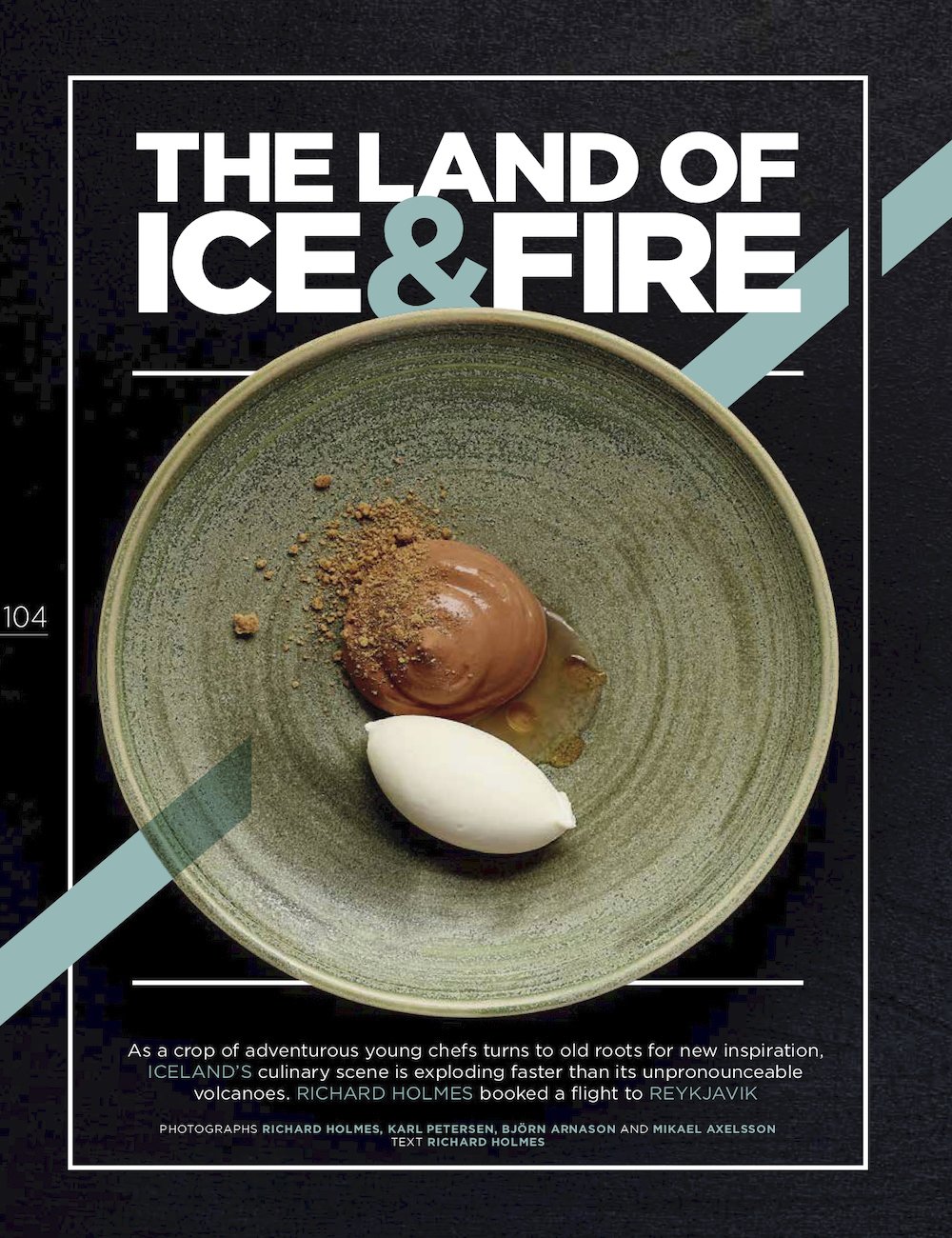First published in Taste magazine (SA).
“This is our bible,” says Steinar Sveinsson, thumping a copy of ‘Matur og Drykkur’ down onto the oak table. The tome of traditional Icelandic recipes – the title translates simply as ‘Food and Drink’ – was first published in 1947, but nearly 80 years on authentic Icelandic cooking is fast seeing a revival in Reykjavik.
“We take the old recipes and prepare them in a new costume,” explains the head chef of the restaurant named in honour of the book. Matur og Drykkur opened just 18 months ago and has quickly blazed a trail in offering a modern take on traditional Icelandic cuisine. “There are some dishes where we keep things in the old style, but we usually try to give them a twist and make them our own.”
Beyond the windows the wind is whipping through the Old Harbour of Reykjavik, the largest city in Iceland and the world’s most northerly capital. It’s mid-summer, but there’s snow on the peaks and the mercury is in the single-digits. It’s a tough island this, and since the first Norwegian sailors settled here in 874 locals have had to be creative with their cooking to get through the bitter winters.
Even today Sveinsson spends the long summer days foraging for wild herbs, his basket full of angelica, chervil and lovage. In mid-summer he’ll add ceps and chanterelles to the mix, all to be dried, pickled and fermented to tide the restaurant through the cold dark months ahead. In Icelandic cooking necessity is, most certainly, the mother of invention.
Take the unforgettable cod dish Sveinsson pushes in front of me. Traditionally boiled into a broth, here the head is roasted whole and basted with an umami-packed stock of chicken and dulse (seaweed). Despite resembling a lucha libre mask, it’s easily one of the most delicious things I’ve ever eaten.
Too adventurous? Try the double smoked leg of lamb with buttermilk and nutmeg. Lamb is a staple on menus across Iceland, with sheep roaming free across the island as they feed on wild angelica, Arctic thyme and seaweed. For dessert, local skyr – a soft cheese with the flavour and consistency of yoghurt – is served with a granita of early-season green strawberries. Delicious.
It wasn’t always this way though. A decade ago Icelandic chefs were fond of flying in ingredients from across the globe, but the 2008 financial crash proved a blessing in disguise for the country’s culinary scene.
“After the crash, many ingredients were so expensive we had to look instead to our Icelandic roots and traditional ingredients,” says Hrefna Rósa Sætran, author, television presenter and owner-chef of the acclaimed Fish Market, which blends Asian inspiration with island produce.
Sætran pays plenty of attention to sourcing top-notch ingredients, and when I finally pin her down for coffee she’s just back from fishing for salmon in the rivers beyond Reykjavik. “If we catch enough, it goes on the menu,” she smiles.
Her kitchen also works closely with local fishing boats: she gets the pick of the day’s catch, Icelandic scallops are brought in fresh, and mussels come from open-water farms in the northern fjords. In marked contrast to the island’s barren landscape the seas here are some of the richest in the world, and city menus brim with fresh seafood unfamiliar to my South African palate: ling and lumpfish, cod and capelin.
“As chefs we need to look to the ingredients we have around us,” says Ragnar Eiriksson, Head Chef at Dill, arguably the top restaurant in the city. “Embrace your surroundings and your traditions.”
The flag bearer for New Nordic cuisine in the city, Dill is unashamedly all about fine dining. The five- and seven-course tasting menus aren’t cheap, but offer a memorable taste of high-end Icelandic cooking. Crispy bacalao pays homage to the cod traditionally hung out to dry in the icy winter winds, while local lumpfish is served both smoked and as rose-tinged roe. Tusk, a fish related to cod, is cured and roasted; plated with pungent shavings of fermented black garlic. It’s adventurous attention-grabbing cooking that has developed a cult following since opening in 2009. If you call today you’ll wait two months for a reservation at Dill.
That’s partly thanks the tourism boom that has swept Iceland over the past five years.
“Tourists are seeking out Icelandic cuisine, and chefs are responding to that. It helps us hold onto our culinary traditions,” says Egill Fannar Halldórsson, one of the founders of The Reykjavik Food Walk [www.thereykjavikfoodwalk.com], which offers food-focused walking tours of the city. Departing from the striking glass-walled Harpa concert hall on the seafront, the tours meander through the downtown district, introducing our motley group to a host of Icelandic staple dishes, and a few surprises.
In the Old Harbour there’s creamy lobster chowder in a bustling harbourside canteen. At the cosy Íslenski Barinn we sample traditional lamb soup: “Every Icelandic mom has her secret recipe, and here the chefs take turns preparing it as they would have it at home,” explains Halldórsson.
At Ostabúðin the small deli counter is piled high with Icelandic cheeses and charcuterie. My favourite? Slivers of wild goose breast, smoked the traditional way over sheep dung.
The next day I explore further on my own. Leaving the pedestrianised shopping street of Laugavegur behind, I discover Brauð & Co bakery; doing a roaring Saturday morning trade in fresh croissants and raisin buns. Locals think nothing of taking a few along to Reykjavik Roasters, which brews up the best coffee in town. It’s a relaxed hipster-friendly place, with tables squeezed around the gleaming Geisen roaster. A jar of the latest roast is laid out on the counter; today it’s El Silencio, a fruity and fragrant bean from Colombia.
Further up the hill, ROK only opened its doors in June but is fast drawing a crowd with its small-plate approach to Icelandic cuisine. The contrast between the traditional turf roof and modern dark wood interior is a perfect reflection of what chef Thorkell Andresson brings to the menu of modern Icelandic cooking.
Here the Minke whale is served rare alongside beetroot and dulse, pickled mushrooms cutting through the richness of the meat. The lamb soup is a more contemporary take on the traditional staple, while the Icelandic fish pie makes the most of what the boats bring in each day. Across the menu, it’s old-school Icelandic given a modern twist.
It’s a trend sweeping across this charming capital city as fast as the relentless westerly wind. Hunkered against the ‘smoky bay’ that gave it its name, Reykjavik may not have the sunny skies of Barcelona or the grandeur of Paris, but a crop of proud young chefs are showcasing what traditional Icelandic cuisine looks like today.



























